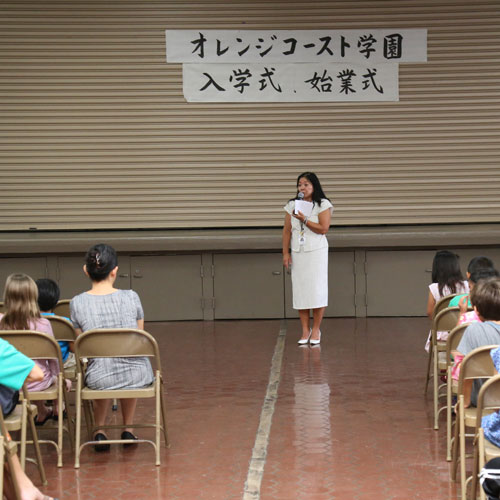Events
The OCG Curriculum includes a wide variety of cultural events that highlight different aspects of Japan. Our teachers have incorporated these events into their classroom instruction. So our students not only get to see a side of Japan they otherwise would never see, they also learn the Japanese language in the process. Most importantly, our students seem to really enjoy these events — especially the always delicious food!
1. Opening Ceremony and Summer Program
The OCG school year begins in late July. Every year our teachers choose a cultural theme for the summer curriculum, which then becomes the basis for our “Summer Festival” at the end of August. One year the theme was how different regions in Japan celebrate the Tanabata (“Star”) festival, and another year we compared school life in Japanese and American schools.
Teachers use the study of these topics to teach vocabulary, kanji, and sentence patterns.
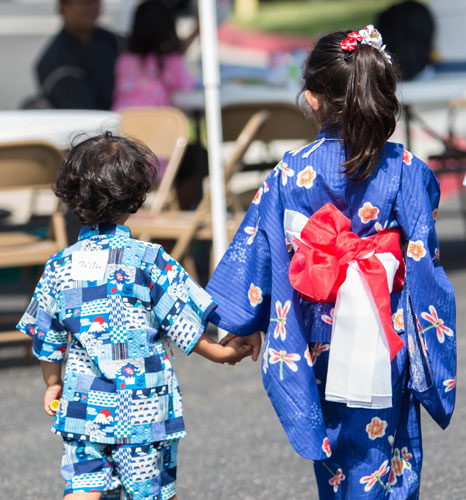
2. Natsumatsuri (Summer Festival)
OCG holds this very enjoyable event at the end of the summer, building on the theme of the Summer program. As with all events at OCG, we incorporate understanding Japanese culture with our teaching of the Japanese language. At the Natsumatsuri students are able to see, and taste, a part of Japan – an opportunity they normally could not enjoy anywhere else.
Each summer we present students with a new set of activities and foods. The festival starts with all learning bonodori (O-bon festival dance). Arts and crafts activities have included origami, making uchiwa (paper fans), and kumihimo, a traditional Japanese braiding technique. Games have included suika wari (a watermelon splitting game), a bean bag toss game, and a fishing game in which students “catch” traditional Japanese yo-yo balloons.
Most OCG events include traditional foods, and the Summer festival is no exception! Over the years we have served many festival foods, including yakisoba (stir-fried noodles), okonomiyaki (a cross between pancakes and pizza), takoyaki (octopus dumplings), and kakigori (shaved ice). The festival also features nagashi somen, in which students use chopsticks to try to catch noodles as they flow down a bamboo trough.
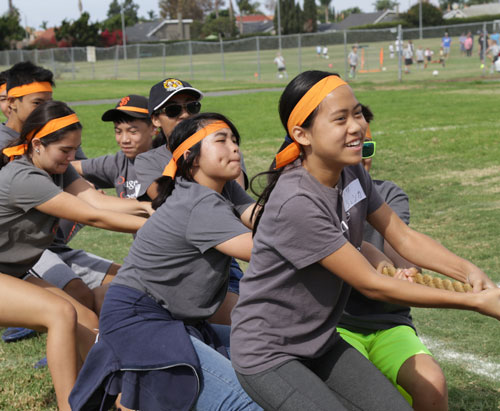
3. Undōkai (Sports Day) // New Student Welcome
Every autumn, schools in Japan hold a school-wide sports day, in which students participate in races and games. Our OCG version is a bit smaller, and held in early October, but still gives our students a sense of what an undōkai is like.
For the undōkai, we divide our students into four teams, each of which includes younger and older students. It is great to see the students cheering each other on, and in the process developing a team spirit and camaraderie.
Each year we start with tama-ire, in which students try to throw bean bags into a bucket that is tied to the top of a tall pole. We then have some relay races, which in the past have included a three-legged race, races involving carrying eggs or balloons, a donut-eating relay race, and others. We then have a tug-of-war, and end up with a final relay race in which all members of all four teams compete. The teachers and parents get into the act, too, participating in the tug-of-war and various other races.
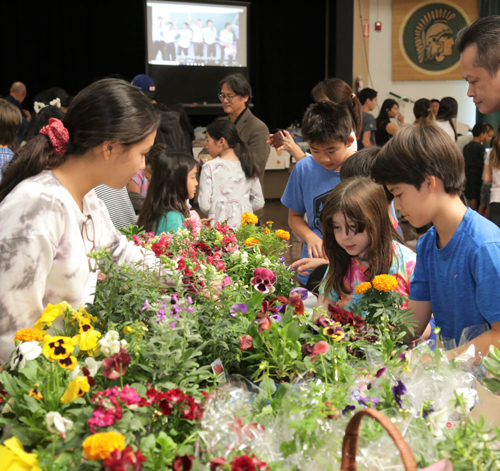
4. Okashi-yashiki and Harvest Festival (in alternate years)
In late October or early November our students participate in a unique learning experience that epitomizes our approach to teaching Japanese. In alternating years we hold a “Harvest Festival,” in which students sell fall-related goods, or the okashi-yashiki (a pun on the Japanese word for “haunted house,” obake-yashiki), in which students sell donated candy.)
In both events our older students are formed into teams and then organize and run different “shops.” For the Harvest festival, students organize different stores – a panya (bread store), a hanaya (flower and plant shop), a yaoya (fruit and vegetable store) , an arts and crafts store, and the like. Last year, the High School students operated a restaurant, the Imo House. For the okashi-yashiki, students display and sell a variety of candy and sweets for Halloween. At the festival, all students and parents enjoy buying these products. (All of the money raised goes to the OCG Student Association.)
These two events are examples of OCG’s innovative curriculum, which stresses hands-on and interactive learning experiences. For each of these shops, the student teams must work together to plan what they are going to sell, how much to charge, how to advertise their store, and how to figure out what profit was made. In the process, the groups use and improve their Japanese language skills in a fun and interactive manner. It is our feeling that students remember more when their language learning is based on concrete and enjoyable activities.
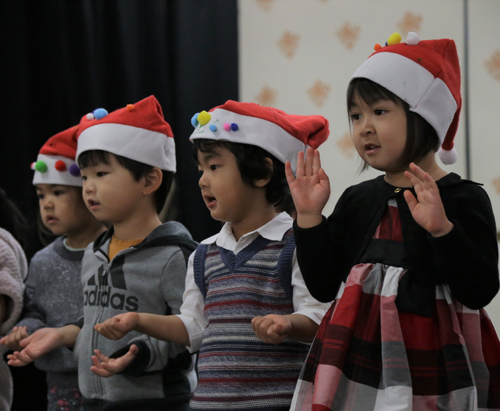
5. Holiday Performance (Gakushū Happyōkai)
To wrap up the Fall semester, OCG holds its Gakushū Happyōkai (Holiday Performance) on the last school day of the year. Each class prepares a short demonstration of the language skills they have learned so far this year, in the form of presentations, skits, songs, or self-introductions. The teachers and students always put a lot of effort into making their presentations interesting and entertaining.
Afterwards, students enjoy a brief visit from Santa, and then an end-of-year pizza party. A very enjoyable way to end the year.
In years past OCG parents have gathered after the event for an end-of-year party.
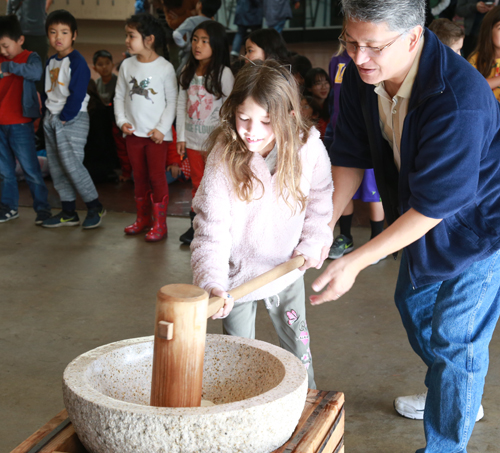
6. Mochitsuki
Every January OCG holds this traditional New Year’s event, in which rice is pounded to make omochi, or rice cakes. Students have the opportunity to use the wooden mallet (kine) to mash the steamed sweet rice in the traditional stone mortar (usu). Students then enjoy the fruits of their labor – eating mochi covered with kinako (sweet soybean flour), or wrapped in nori and dipped in soy sauce.
As we now do with all of our cultural events, the teachers use the occasion to base some language lessons on mochitsuki-related themes. For instance, one year one of our older classes compared regional differences in ozoni (mochi soup) and then cooked and served different samples.
We have also included other cultural events right after the mochitsuki ceremony. In the past, we have had a demonstration of taiko (Japanese drums), karate, and o-shūji (Japanese brush calligraphy).
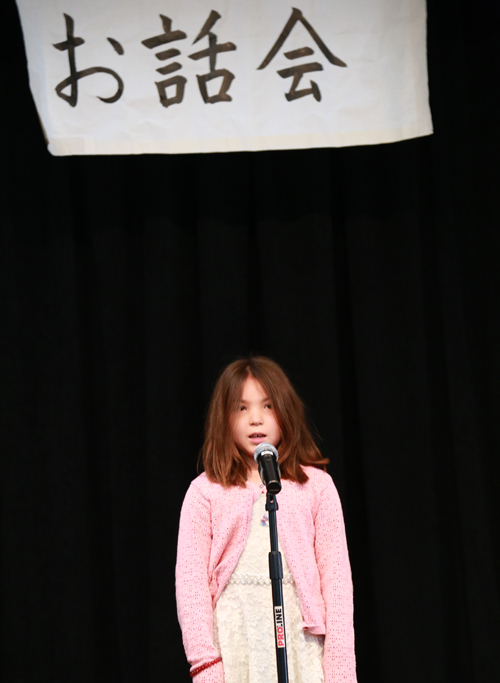
7. Ohanashikai (Speech Contest)
In the spring, all OCG students participate in our annual Speech Contest. Students write their own speeches, using their own words, and then work with their teachers to improve and refine their presentations. (From the 2013-14 school year we will hold the Speech Contest every other year.)
Students then give their speeches in a formal setting, in front of judges, fellow students, family, and friends. This annual event gives our students the chance to express their opinions in Japanese, showcase their language skills, and learn the art of public speaking.
Trophies are awarded to the top speakers from each class.
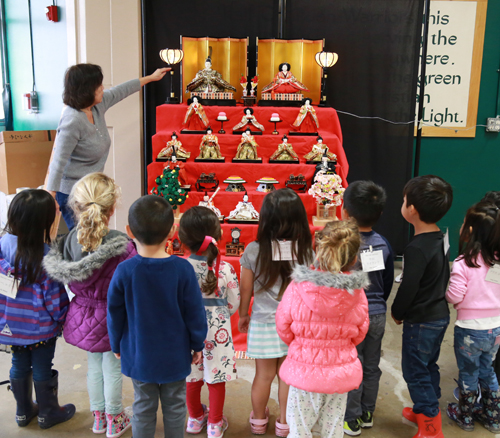
8. Other Cultural Events
Setsubun/Mamemaki. In Japan, Setsubun (a day marking the end of Winter and beginning of Spring) is celebrated on February 3. Part of the traditional ritual is to drive out evil by throwing “lucky beans” at an Oni or devil (actually some of our parents wearing colorful masks!).
Hinamatsuri (Girl’s Day). Every March 3rd in Japan is Hinamatsuri, and is celebrated by displaying a set of traditional dolls. At OCG we are lucky to have a full-sized and very elaborate doll display. We also serve traditional Japanese foods.
Kodomo no hi (Children’s Day). May 5th in Japan is Kodomo no hi (Children’s Day), in which all children are celebrated. At OCG, we display not only the traditional kabuto (samurai helmet), but also a full-sized set of samurai armor. We also serve traditional Japanese foods, such as kashiwa mochi (mochi wrapped in oak leaves).
OCG also includes other cultural presentations at the Children’s Day festival. In the past we have had a karate demonstration by a local school, and a demonstration of the koto (a 13-stringed Japanese musical instrument).
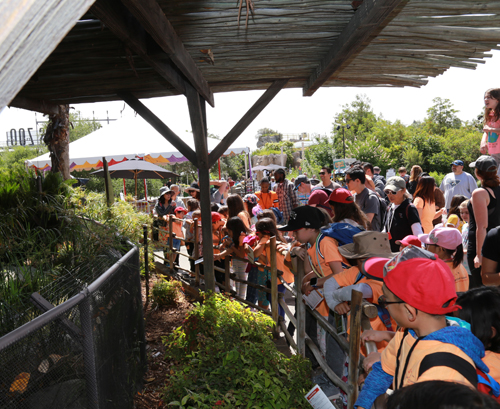
9. Field Trips and Special Events
OCG holds periodic special events. Since 2013 we have conducted a school-wide Field Trip. We do this in the year that we hold the Harvest Festival, using the money that students raise in that event. The students not only enjoyed themselves, they also built up more school spirit.
Our field trips have included the following:
- 2019: Los Angeles Zoo
- 2017: Long Beach Aquarium
- 2015: California Science Center
- 2013: Griffith Observatory
In 2013 we hosted a visit from a group of Alaskan students from the small town of Beaver, who were also studying Japanese. Our advisors arranged this very interesting visit. We exchanged presentations of cultures, and went for a tour of the Balboa beach area.
In 2015 OCG celebrated its 40th anniversary as a school, and our 5th year as a completely independent school. Many faces from OCG’s past joined our current parents and teachers in a fun-filled afternoon.




